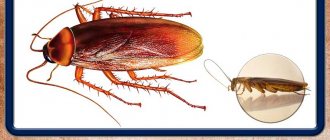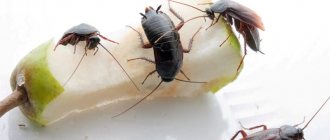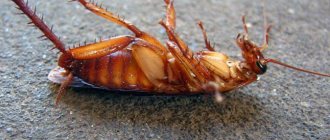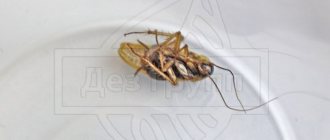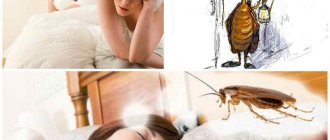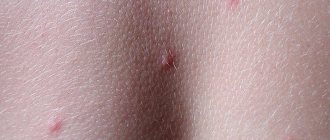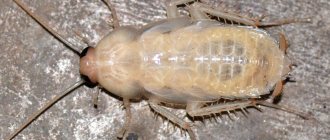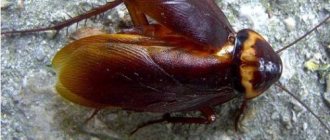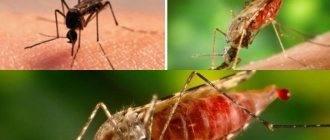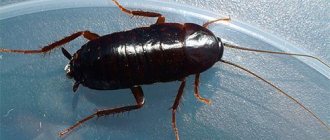Peculiarities of cockroach reproduction
Having figured out how cockroaches breed, the owner of a living space may become depressed. This is explained by the fact that cockroaches do not have a clearly defined time period for reproduction. The appearance of new individuals is observed throughout the entire 12 months.
If you miss the moment and don’t start fighting them in time, then it will be very difficult to get rid of such “tenants” later.
How do they reproduce?
There is nothing special about how cockroaches reproduce. Like most other living things, they do this sexually. The process of reproduction is preceded by mating games of sexual partners, after which they perform sexual intercourse.
One intercourse is enough for the female to self-fertilize several times in the future without the participation of a male.
Small cockroaches develop as follows:
- The female cockroach lays an ooteca (cockroach eggs are placed in a special leathery sac). Red and black representatives of this family of insects carry eggs on themselves, while other individuals lay them in hard-to-reach places.
- 14-21 days after laying, new individuals emerge from the abdominal sacs in the form of larvae.
- Larvae or nymphs (miniature copies of adults) molt several times during development and eventually transform into mature adults.
A female black cockroach carries up to 10-20 larvae in one egg, and a female black cockroach carries 20-30. At most, a female cockroach can produce up to 40 new larvae at one time. This number of new young individuals is enough to completely fill the apartment in the shortest possible time.
What determines the rate of reproduction?
If the female carrying the ootheca with future offspring is in favorable conditions (there is free access to food and drink), then the entire cycle of larval maturation occurs in 5-7 weeks.
But if food supplies are weak or the temperature in the room is too low, then the pregnant individual does not give birth, but wears the capsule on herself for several months, since the development of the larvae under such conditions slows down significantly.
The most active breeding season for cockroaches occurs at night. In the absence of daylight or artificial light, they begin to lead an active lifestyle.
While the owner of the home sleeps peacefully, insect mating takes place in his kitchen, leading to a rapid increase in the number of colonies.
The rate of reproduction of Prussians directly depends on the ambient temperature in the room. If the temperature is reduced to 10 °C, then some of the parasites will die immediately, while others will lose the ability to further develop normally.
Some consider temperature changes as a good method of controlling parasites. With the help of cold it is possible to exterminate entire colonies.
How does fertilization occur in females?
Cockroaches reproduce through sexual contact. After the individuals mate, the cockroach is able to become fertilized 1-3 times. Moreover, during subsequent fertilization she will not need the help of a male individual.
This is due to the fact that a female is capable of retaining reproductive cells of the opposite sex in her body for a long time.
After fertilization, the female insect lays eggs enclosed in a special protective shell. The life of new individuals, separate from the mother, begins in the form of larvae, which go through 3 molts throughout their lives and eventually turn into an adult female or male.
How often does a cockroach reproduce?
The lifespan of such a parasite can vary greatly. In order for the pest to live longer, the most comfortable conditions must be created for it. Most of the life of cockroaches occurs during the period when they are already sexually mature individuals.
The larvae develop quite quickly and become adult females and males in 4 weeks. This reproduction rate is considered quite fast, and the population of cockroaches can be replenished very dynamically.
These creatures do not have specific seasons for breeding.
The process of emergence of new individuals is observed throughout the entire 12 months, which greatly complicates the fight against them.
If there are cockroaches in the apartment, then you need to understand that during their life cycle, females of black or red members of the family can lay from 4 to 9 ootheca, and this implies the birth of about 450 new individuals.
Video
The birth of cockroaches
Sexual differences in cockroaches
Cockroaches are dioecious insects. The reproductive system of males and females has a rather complex structure. You can distinguish a female cockroach from a male either by dissecting the insect under a microscope and studying its internal structure, or by visual inspection.
How to determine gender?
There are three main external differences between female and male cockroaches:
- size – female cockroaches are larger and their body is wider;
- wings - in males they are more developed;
- external reproductive organs - in males, the genital plate is located on the last segment of the abdomen.
Outwardly, it is easiest to distinguish a female from a male by the first two characteristics. The male is more slender and his wings are visible to the naked eye.
The intimate life of parasites
If food, water and comfortable temperature conditions are available, the breeding season of cockroaches is not limited to a certain season; insects breed all year round. When a female reaches puberty, her genitals begin to secrete a special odorous substance that attracts males, signaling their readiness to mate. For the same purpose, the female flaps her wings.
The larger wings of the male also play an important role in the process. They serve as a supporting platform on which the partner can comfortably sit. Cockroaches mate for only a couple of minutes, after which the male goes to look for a new partner.
How to distinguish a male from a female
Many people know what a cockroach looks like, but how to distinguish a male from a female remains a mystery to some.
Knowing the following differences can help with this:
- Wings. Males have more developed wings, which allows them to fly over minor obstacles in search of food or water.
- Size. When examining several individuals of such parasites, you will notice that there are large ones, as well as smaller ones. The male is usually noticeably smaller than the female.
- Leads. The puberty of the male is indicated by special growths on the back of the body. Females do not have such an anatomical element.
Female cockroaches also have wings, but they do not use them for their intended purpose. As a rule, females lure their sexual partners into intercourse with the flapping of their wings.
What is ootheca?
Literally translated, this word means “egg storage.” This is true: a small chitin capsule reaches a size of only 10-12 mm (in domestic red cockroaches), but inside it can contain 30-40 cockroach eggs filled with a protein substance. This mass reliably protects future insects from adverse external influences.
When apartment owners poison cockroaches, only the larvae and adults that come into direct contact with pesticides die. Deferred oothecae are invulnerable to many of the agents that are currently known. They can retain their contents even when insects are frozen: the dense shell and the filling mass are able to provide a temperature acceptable for the life of the eggs for a long time.
After the owners have finished treating the apartment and are quietly enjoying the absence of harmful neighbors, a new colony of cockroaches is preparing to be born somewhere in a secluded place. The maturation of eggs lasts for 14-30 days from the moment they are laid in the capsule. But the female cockroach carries it on herself for some time, leaving it only in an ideal place for this. Therefore, it is impossible to predict for sure when the birth of cockroaches will occur.
Behavior of female and male
After fertilization occurs, the female cockroach lays eggs in a special compartment, from which the larvae will subsequently hatch and gradually transform into adults.
But mating of females and males does not occur automatically, but is preceded by a long period of courtship.
Several males can compete for one female. They enter into a real battle, winning their right to reproduction and reproduction. Wings come in handy here. They can wave them in a frightening manner, and also make accompanying sounds aimed at scaring away a competitor.
The fact that the female is ready for intercourse is indicated by certain pheromones, which are secreted by special glands. This smell becomes a signal for the male. Mating itself lasts only a few minutes. The further fate of the offspring largely depends on the conditions in which domestic cockroaches live.
In the wild, the reproduction process usually slows down. If the female has nothing to eat and drink, then dynamic reproduction cannot be expected. If an individual settles in a warm apartment or house and there is always access to food, then new parasites will appear in a matter of days, causing a lot of trouble for the owners of the home.
Interesting facts about cockroaches
- The dexterity of cockroaches is due to the presence of small hairs on their legs. They react to even minimal air movements and allow their owner to hide long before the person crosses the threshold of his apartment.
- In addition to powerful jaws, insects have special teeth in their stomachs, which are involved in all digestive processes and help to better process and assimilate any food.
- Having made an unsuccessful landing from one surface to another, the cockroach risks falling on its back and soon dying a painful death. The thing is that their coordination leaves much to be desired, and without additional support there is no opportunity to stand on their paws.
- Scientists have proven that an insect that for some reason has lost its head can live without it for a sufficient amount of time if it avoids contracting an infection. It will breathe as usual - through the breathing holes located throughout the body. He won't be able to bleed, because... They have no blood pressure, and can live comfortably for about a month without food.
- Cockroaches are the only creatures on our planet that are more capable of surviving a nuclear explosion. As is known, cells respond to radiation only during division, which occurs in insects during molting (about once a week). In the end, this will only affect ¼ of the entire population.
How long does it take for a cockroach to grow?
If we evaluate the entire life of a cockroach, it becomes obvious that most of it occurs during the period when the creature is in the imago stage. Nymphs grow quickly - they become sexually mature individuals in 4 weeks. Cockroaches are insects that have an incomplete development cycle.
The entire process leading to the appearance of sexually mature individuals is divided into several stages:
- Laying eggs. At this stage, the task of a sexually mature female is to lay eggs in an ooteca (a sac located on the female’s abdomen), filled with a special glue that holds the eggs together. Before the eggs are fully mature, the ootheca is clearly visualized on the female’s abdomen. Over time, up to 40 young cockroaches can hatch from it.
- The period of maturation of the egg and its transition to the larva can be 2-4 weeks. For the ripening process to proceed smoothly, the ambient temperature should be 30 °C plus. If the ambient temperature drops, then this process slows down, and at 10 °C it stops completely.
- When the eggs are fully ripe, the female folds back her abdominal pouch and larvae, called nymphs, begin to hatch from it. These young cockroaches have no wings at all and are usually darker in color than the mother. This allows you to distinguish the larva from the adult.
If the nymph feeds well for 8 weeks and the surrounding conditions are suitable, it will transform into an adult female or male. Throughout this entire period of time, the nymph changes its cover several times.
Not myths about the nymph
It is not difficult to distinguish a nymph from an adult. The larval nymph is smaller, has not yet developed wings , and is darker in color. The larva molts 5-6 times during its growth and sheds its old shell. The closer the nymph is in age to a mature individual, the lighter it becomes, turning from almost black to red.
Nymphs live in a colony with adults and eat the same food. They behave exactly the same, only they do not mate.
10 interesting features that make them incredibly durable:
- After mating, the male's gametes are stored in the female's body for a long time, and repeated clutches can occur without the prior participation of the male. That is, it is enough for a female to “communicate” with a male once in her life in order to then calmly and repeatedly leave offspring.
- Can live without a head . All his organs continue to function. But without a head, the body will not last more than a week for the reason that it will not be able to drink and will die... from thirst.
- Can hold your breath for 40 minutes . Scientists believe that this feature came in handy millions of years ago, when things were not going smoothly with the earth’s atmosphere.
- Barbels are very lazy . They spend three quarters of their lives in a state of rest.
- Runs very fast . If he runs, it will be very fast - 4.8 km per hour. This is a lot, considering the size of his legs.
- Maybe eat once a month . And at the same time, he can eat everything. For this he has powerful jaws.
- Impossible to catch . He will feel you with all the hairs on his paws. And when he starts running, he will change direction 25 times per second. You are doomed to fail.
- They will withstand an atomic explosion and survive . They have a particularly slow cell division cycle and are not afraid of radiation.
- They have two pairs of wings. The upper ones are dense and leathery elytra of the body protection - we see them. And the lower ones - thinner ones - are hidden under the elytra. With the help of them he flies.
- The largest cockroach - 9 cm in length - does not live in our houses. He prefers tropical forests.
Fact . The red cockroach is the leader in the fight against the black one:
- he reaches puberty faster;
- more fertile;
- takes better care of its offspring and even feeds on the eggs of its opponent.
How many cockroaches can be born at one time?
A Prussian can have a brood of 25-35 nymphs from one capsule. Other species can boast more numerous offspring. In some, the number of larvae reaches 60. Cockroaches reproduce rapidly, since offspring are born quite quickly.
At first the larvae are white, but gradually they begin to darken and harden. Literally immediately after birth, nymphs can feed on their own, which means that they have become equal members of the population.
How to prevent mass reproduction
Chemical treatment is perhaps the most reliable and fastest way to get rid of these pests in the house. In this case, the insects die almost immediately, but this does not in any way affect the larvae, which at this moment are still in the ooteca. After some time, they will quietly hatch, and the problem with cockroaches will arise again.
To avoid this, after the first disinfestation, this activity should be repeated after 2 or 3 weeks in order to “finish off” the hatched young.
In addition, it is important to maintain cleanliness in the house: do not leave food open, take out the garbage on time, monitor the humidity in the apartment, and then the chances of unwanted neighbors will become much less.
Cockroaches can release gases, and after death they continue to release gases for another 18 hours, so cockroaches can be called the stinkiest insects in the world, and not bedbugs, as many believe.
How long do insects live?
The lifespan of a cockroach can vary from 4 months to 4 years. The timing and time periods largely depend on living conditions. It has been scientifically proven that Prussians can go without food for up to 50 days, and blacks - up to 70.
Parasites can live much longer without food, but without water they can live only 7 days.
This is due to the fact that water gradually evaporates from the insect’s shell, and if its reserves are not replenished, the insects literally “dry out” and die.
What affects the rate of reproduction
The total hatching time depends on environmental factors such as temperature and humidity. Dioecious cockroaches reproduce faster and their larvae are more viable. The population is growing right before our eyes.
How to speed up the reproduction of cockroaches?
You'll have to work hard here. If you raise cockroaches to feed your anphibia, you need to maintain a balance of heat and moisture and feed the cockroaches with vitamins. For example, orange slices act on them like Viagra.
To best manage your cockroach breeding colony, you should maintain a ratio of approximately 1 male to every 5 females, maintain temperatures between 32 and 35 degrees Celsius, and monitor hatching rates. If the indicator decreases significantly, although you are doing everything correctly, this means that most of the females have become old and give birth less than the younger ones. In this case, more females must be allowed to mature and reproduce.
Is it possible to slow down the reproduction of cockroaches in an insectarium?
It is enough to lower the temperature and all life processes will slow down.
Can 1 cockroach reproduce?
One cockroach can reproduce if it is a female who had sexual contact with a male before moving into a particular apartment. In this case, she reproduces at the expense of the male’s gametes that remain in her body.
The survival rate of cockroaches is very high and in good conditions their numbers increase rapidly. If one individual was noticed, then over time there will be many more of them.
Cockroaches do not live alone; their settlements usually represent entire colonies. Such groups include several sexually mature male and female individuals, as well as offspring. Adults teach babies to adapt to difficult environmental conditions, as well as to look for food every day.
If at least one cockroach has been found, then there is absolutely no point in delaying their elimination, otherwise this could lead to the appearance of an incredible number of insects.
What conditions are most favorable for the development of cockroaches?
Although cockroaches are considered one of the most tenacious insects, in reality they are very dependent on environmental conditions.
Temperature dependence
Too low and too high air temperatures can negatively affect the development of the younger generation. The most favorable air temperature for cockroaches is considered to be around +25 - +35 degrees Celsius, at which they grow and develop much faster.
Reaction to minus marks
Lowering the temperature to +15 degrees can have a negative effect on cockroaches. Adults become weaker and even stop reproducing, and egg laying and larvae slow down greatly or even stop in development. As for negative temperatures, a mark of -5 degrees can be destructive for adult cockroaches, but will not harm the eggs inside the ootheca. For the latter, the only danger is a drop in temperature to -15 degrees Celsius.
Humidity dependent
Humidity levels also play an important role in the development of cockroaches. These insects are very dependent on the source of water and the main reason for their appearance in apartments is most often not crumbs and leftover food on the tables, but the presence of a constant source of water.
Reaction to excessive dryness
If the air in the room is too dry and there is no open access to water nearby, then very soon the insect’s body will lose the necessary moisture and will cease to function normally. Too high a room temperature can evaporate moisture and make the air dry, which is dangerous for cockroaches.
Prevention of the appearance of red cockroaches in the apartment
- If you find out that there are Prussians in a neighboring apartment, do everything possible to prevent them from moving in with you. To do this: Equip all ventilation openings with a mosquito net.
- Fill cracks in walls, floors and ceilings.
- Seal cracks near the riser and pipes.
Video: three proven ways to get rid of cockroaches
How to understand that an “infiltrator” has entered the house
Just because you have not encountered pests directly does not mean that they are not in the house. Signs of the presence of cockroaches in an apartment are as follows:
- insect excrement - black spots on wallpaper, furniture, dishes;
- unpleasant odor - the appearance of an “aroma” that is not associated with the activity of domestic animals or spoilage of food;
- eggs - laying eggs in secluded corners;
- extraneous noise - faint rustling and rustling sounds at night;
- the remains are empty chitinous shells on the floor and in the cabinets.
Preventive actions
The rate at which insects reproduce depends on the situation in the house.
Therefore, preventive measures are carried out periodically:
- Regular cleaning of the house. There are no pests in a room that is free of organic remains, crumbs and grains.
- Checking the condition of communications and pipelines. Without food, insects live 7 or more days. If there is no water in the house, they will quickly leave it.
If chitin or excrement is found in the kitchen or bathroom, then it is necessary to carry out treatment. For these purposes use:
- Chemicals. Gels and pastes, aerosols and sprays are available for sale. Among the presented assortment, you can choose chalk or powder. The supplied drugs differ in composition and duration of action.
- Traditional methods. Traps and baits are popular among housewives. Their preparation will not take much time. To do this you will need boric acid or borax. To lure insects, you need to add vegetable oil to the powder.
The sanitary conditions in the house affect how long cockroaches live.
Reasons for the appearance of red cockroaches
There are many reasons why Prussians may appear in your home.
From neighbors
If your flatmates have declared war on insects, cockroaches may scatter en masse around the area in search of salvation. And with the help of a garbage chute, cracks in walls, windows, ceilings will get into your apartment.
Red cockroaches can get to you through the ventilation hole from your neighbors
After going to the store or work
You can bring the Prussians into your home along with your purchases from the store, or they can get into your bag at work. Sometimes pests move directly to your purchase - a system unit, cabinet, TV, etc.
With parcel
With the spread of online shopping, cockroaches now have even more transportation to move around. Therefore, you can get “roommates” right in the box with a new luxurious dress or phone.
Why are cockroaches harmful and are they dangerous?
Perhaps the Prussian can be called an omnivore, because he is able to eat any things of non-synthetic origin. Of course, most often he eats up the leftovers from the master's table, that is, crumbs and the like. But in their absence, he does not disdain fabrics, leather from clothes, book bindings, shoes, soap and even paper. In addition, pests can chew on the insulation of electrical appliances, which can lead to a short circuit.
While you sleep, a red cockroach can crawl into your ear.
The Prussian's favorite habitat is a trash can and cracks in the floor. That's why all the microbes end up on the cockroach's body. By contacting fresh food, the surface of the dining table and other kitchen furniture, the parasite easily spreads a variety of diseases, especially of the gastrointestinal tract:
- diarrhea;
- dysentery;
- gastroenteritis;
- hepatitis;
- tuberculosis, etc.
In addition, the Prussian can carry worm eggs on its paws, and the chitinous cover periodically shed during molting can cause allergic reactions in the inhabitants of the house. In very rare cases, the parasite mistakes your ear canal for an excellent hiding place and crawls into it at night while you sleep. In this case, consult a doctor immediately.

